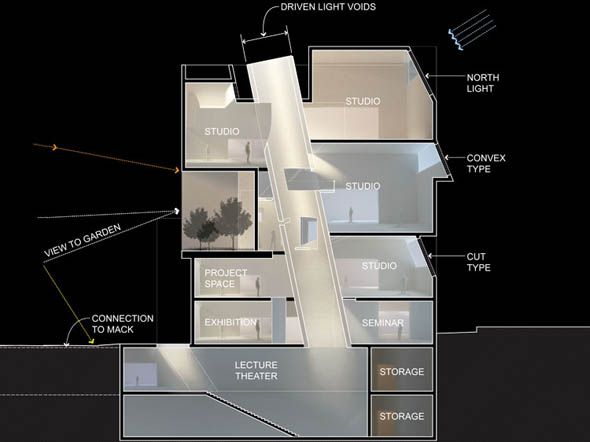Steven Holl Architects wins Glasgow School of Art competition

The Glasgow School of Art (GSA) is delighted to announce that Steven Holl Architects working with Scottish based JM Architects has been selected, as the result of an international competition, to lead the team to design a new building on the site opposite the world famous Mackintosh Building in Garnethill, Glasgow.
Steven Holl Architects is a leading New York based practice which has been recognized internationally with some of architecture’s most prestigious awards and prizes. These include recent awards from the American Institute of Architects and the Royal Incorporation of British Architects for the Nelson Atkins Museum of Art in Kansas City and the School of Art at Iowa University. Awards have also recognised their commitment to sustainable design. Recent work includes the Herning Centre for the Arts in Denmark and a major development in Beijing where they also have an office. They will work with Henry McKeown and Ian Alexander, award winning directors from the Glasgow office of JM Architects.
The brief for Steven Holl’s team is to work with GSA to refine the Masterplan for GSA’s Garnethill estate redevelopment and to design and deliver Phase 1, a new building to significantly enhance the teaching, learning and research facilities available to GSA students and staff and the access which the public can have to their work. The building will sit opposite the Mackintosh Building, recently voted the UK’s favourite building of the past 175 years in a national survey run by the Royal Institute of British Architects. The in principle support of the Scottish Funding Council has been essential in enabling the School to move to this stage.
It is particularly appropriate that this announcement comes just over 100 years after The Glasgow School of Art held its first architectural competition when it invited submissions from 11 architects’ practices for a new school in the centre of the city. The winner was 28- year-old Charles Rennie Mackintosh (then working for Honeyman and Keppie), whose Mackintosh Building, will remain at the heart of the new urban campus and the educational experience of every GSA student.
This 2009 competition, which was to find an architect-led team and not to select a design, received submissions from over 150 international firms from which seven were shortlisted (in alphabetical order): Benson & Forsyth (London, UK); Elder and Cannon (Glasgow, UK); Francisco Mangado Architects with ZM Architects (Pamplona, Spain and Glasgow ); Grafton Architects (Dublin, Ireland); Hopkins (London, UK); John McAslan and Partners with Nord Architects (London and Glasgow); Steven Holl Architects with JM Architects (New York and Glasgow).
The final and unanimous decision was reached after a rigorous process, against set evaluation criteria, of submissions, presentations and interviews, by a Selection Committee chaired by Barcelona based architect, David Mackay. The Selection Committee considered that Steven Holl Architects’ work showed a poetic use of light and their submission demonstrated a singular creative vision, scale of ambition, profound clarity and a respectful rivalry for the Mackintosh Building. The Committee believed that Holl’s approach to the craft of building, his understanding of the opportunities of new technology and an enjoyment of the challenges of sustainable design, promised a great step forward in the development of architecture in an urban setting.
About the competition win, Steven Holl, architect, said: “We are thrilled to be selected for this very important project for the new Glasgow School of Art. It is an honour to make a new architecture for a 21st century school of art across from Mackintosh’s inspiring masterwork of the early 20th century. Since my student days at the University of Washington the amazing Mackintosh building with its tremendous light and magical scale has been a seminal reference. Mackintosh’s manipulation of the building section for light in such a variety of inventive ways has inspired our approach toward a plan of studio volumes shaped by light and connected by a “˜Circuit of Connection’ which encourages the creative contact central to the workings of the school. 100 years after completion, Mackintosh’s building continues to inspire as a work of architecture and a place to make art. The invention of an original architectural language is a fresh today as it was then. Its intensity of detail, light and material calls for the highest aspirations of a phenomenologically-driven architecture of our time. We feel the urgency of recovering the integral action of “thinking and making” in the use of the highest new technologies available. We imagine the new Glasgow School of Art to be a celebration of Knowledge: the phenomenological techniques of tomorrow.”
